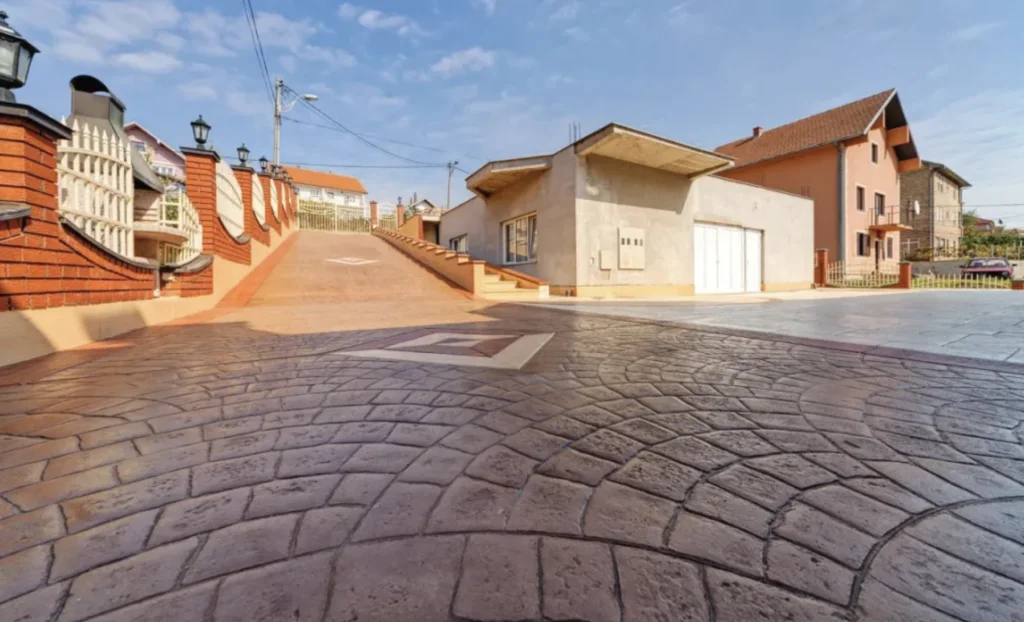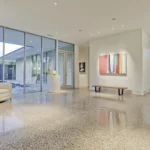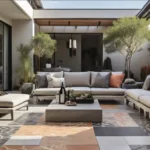Choosing the right stamped concrete color for your home can be a challenge. With nearly limitless color options and patterns that mimic natural materials, stamped concrete is an excellent way to enhance your home’s aesthetic. Here’s how to make a choice you’ll love for years to come.
Stamped concrete offers a fantastic way to add character to your home’s exterior and interior spaces. It can mimic materials like stone, brick, or wood, providing both durability and beauty. However, picking the right color is essential to achieve the desired look.
Why Choose Stamped Concrete?
Stamped concrete is not only visually appealing but also offers excellent value. It can transform patios, driveways, pool decks, and even interior floors. The cost is often lower than using natural materials, and it provides flexibility with custom patterns and colors.
Understanding Color Options for Stamped Concrete
Stamped concrete colors are created with integral color (mixed into the concrete) or color hardeners (applied to the surface). These colors range from earth tones to bold hues, giving homeowners nearly endless choices.
5 Tips for Choosing the Right Color

1. Don’t Be Afraid of Dark Colors
Choosing a darker color may seem intimidating, but keep in mind that concrete lightens as it cures. Darker colors also tend to hold up better under exposure to sun and weather, maintaining a rich look over time.
2. Consider Using Multiple Colors
Combining colors can add depth and texture, especially if you want to replicate the appearance of stone or brick. A blend of two or more shades can create a more realistic effect, enhancing outdoor spaces like pathways, pool decks, or patios.
3. Match with Accent Colors in Your Home
Instead of matching the dominant color of your home, look to complementary shades in your home’s trim, siding, or roofing. For example, a deep red for the concrete might complement a brick home, while a soft brown could echo wood or natural stone accents.
4. Choose Colors Based on Climate
Darker colors absorb heat, which may be beneficial in cooler climates, adding warmth to the environment. For warmer climates, lighter colors reflect sunlight, keeping surfaces cooler.
5. Extend Concrete Indoors and Outdoors
For a seamless transition from indoor to outdoor spaces, consider using the same or similar stamped concrete color for floors inside and outside. This approach can make spaces feel larger and more cohesive, whether connecting a kitchen to a patio or a basement to a backyard.
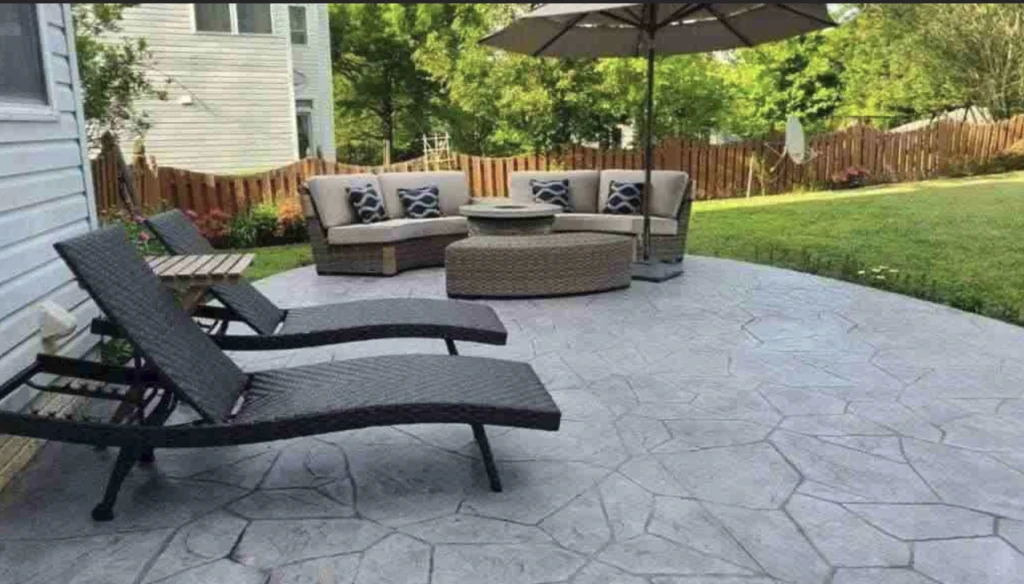
How to Test Colors Before Deciding
One of the best ways to test colors is by applying small samples to an area where the stamped concrete will be laid. Observe how the color looks in different lighting conditions, and remember that the shade will lighten as it dries.
Color Effects Over Time
With time, stamped concrete colors may lighten slightly. Environmental factors, like exposure to sunlight and rainfall, can cause subtle changes, so selecting a slightly darker color may ensure a better match long-term.
Professional Tips for Color Longevity
Applying a high-quality sealant can help maintain the vibrancy of the stamped concrete color. Reapplying the sealant every few years helps protect against fading, wear, and damage from environmental factors.
Common Mistakes to Avoid
- Choosing Colors that Blend Too Much: If your concrete color is too similar to your home’s exterior, it may lack contrast and visual appeal.
- Overly Bright Colors: Bold colors can fade or become less appealing over time, so neutrals or earth tones may be better for a timeless look.
Using Sealants for Color Protection
A sealant adds a protective layer that guards against fading, stains, and weather damage. Consider using a UV-resistant sealant if your stamped concrete will be in a sunny area.
Maintenance for Long-Lasting Color
Routine cleaning and resealing every few years can help maintain the original color of your stamped concrete. Avoid using harsh chemicals, and regularly remove debris and dirt that can wear down the surface.
Comparing Stamped Concrete to Other Materials
Stamped concrete is often a cost-effective and visually appealing alternative to stone or brick. Unlike natural materials, concrete is more versatile and durable, requiring less maintenance.
Cost Factors of Different Colors and Patterns
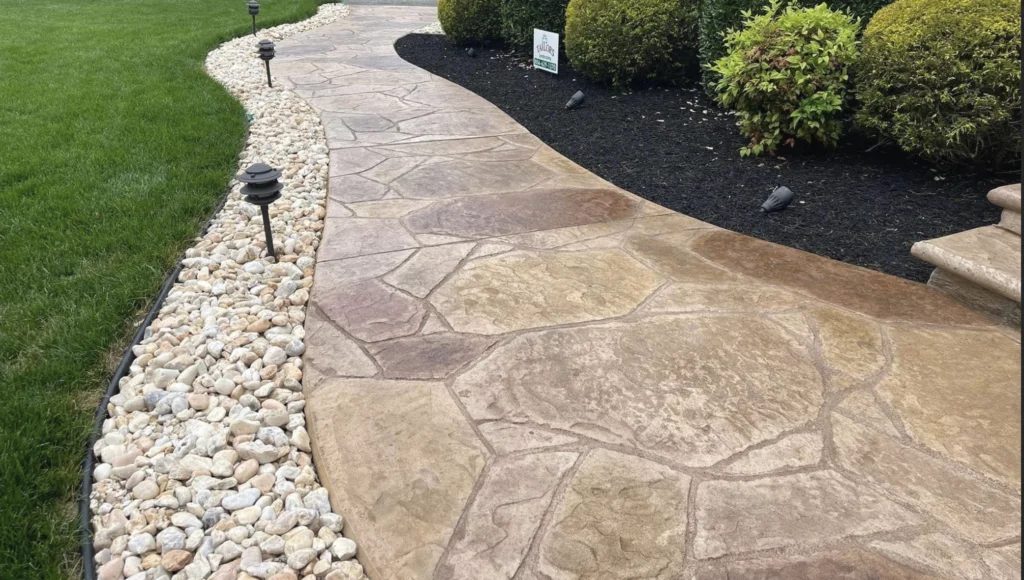
The color and complexity of the design will affect the cost. Multi-colored designs or intricate patterns generally require more materials and labor, making them more expensive than single-color applications.
Conclusion
Selecting the right stamped concrete color is an art and a science. By considering factors like color blending, climate, and matching your home’s accents, you can create a look that’s both beautiful and functional.
FAQs
1. What are the most popular stamped concrete colors?
Popular colors include earth tones like beige, tan, brown, and charcoal gray, as they blend well with natural surroundings and home exteriors.
2. Can stamped concrete colors fade over time?
Yes, colors can fade slightly due to exposure to sun and weather, but sealants help maintain the color for a longer period.
3. How often should I reseal my stamped concrete?
For optimal protection, reseal stamped concrete every 2-3 years, depending on exposure to weather and foot traffic.
4. Is stamped concrete more affordable than natural stone?
Yes, stamped concrete typically costs less than natural stone while offering a similar appearance and durability.
5. Can stamped concrete be used indoors?
Absolutely! Stamped concrete can be used in basements, living rooms, or kitchens, creating a unique and cohesive look that flows from indoors to outdoors.

